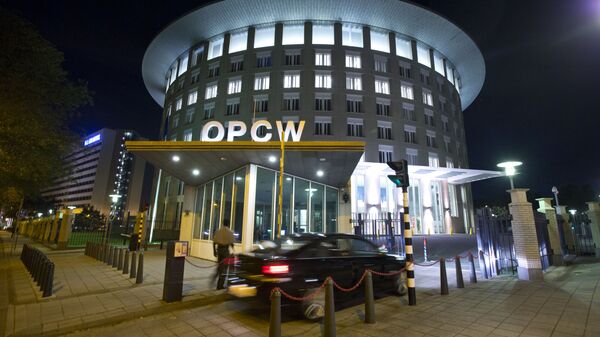The WikiLeaks whistleblowing website recently published a new batch of documents related to the drawing up of the final report by the Organisation for the Prohibition of Chemical Weapons on the alleged chemical attack in Douma, painting a worrisome picture of how a major portion of the evidence collected by the fact-finding mission (FFM) was neglected in it, along with the team's version of what happened in April 2018.
Apart from internal memos and emails showing that OPCW staff had internally expressed concern over how the report was made, WikiLeaks published two versions of the organisation's report: the final draft that was officially published, and the first draft, or interim report – how it looked before it was slashed in half and significantly rewritten in certain parts.
While the changes made to the interim report are numerous, Sputnik has gathered some of the key points that changed on the document’s path to its final draft.
OPCW Report Changes: Toning Down Evidence of False-Flag Attack
One of the main differences between the interim OPCW report on Douma and the final version, which is half as long (not counting appendixes), is that the latter omits many facts and much evidence that was found by the FFM. These details cast major doubt on the claim that an actual chemical attack with the use of chlorine gas took place in April 2018 and not a false-flag one.
Namely, the authors of the interim report indicated that there was "insufficient evidence" to prove that a poisonous substance had been released from cylinders found at two sites in Douma, while the final report showed significant confidence in the delivery method of the gas.
"The team has sufficient evidence at this time to determine that chlorine, or another reactive chlorine-containing chemical, was likely released from cylinders", the final report said.
The final version also toned down its language in regards to speculation that these cylinders might have been intentionally planted and not dropped by aircraft, as was claimed by some witnesses, saying that the OPCW is "still progressing in relation to the location of the cylinder, its provenance on the roof and the damage to both the rebar-reinforced concrete terrace and the cylinder". The interim report directly indicated that there were reasons to doubt that the cylinders had actually been dropped from above.
"The FFM team is unable to provide satisfactory explanations for the relatively moderate damage to the cylinders allegedly dropped from an unknown height, compared to the destruction caused to the rebar-reinforced concrete roofs. In the case of Location 4, how the cylinder ended up on the bed, given the point at which it allegedly penetrated the room, remains unclear", the interim report said.
The interim report specifically stressed the unexplainable positioning of one of the cylinders, which ended up on a bed three metres away from the alleged entry point in the building's roof after presumably crashing in at a 90 degree angle. The final report simply stated that additional assessment of its trajectory was needed, without specifying why.
"It was not apparent how a cylinder that seems to have entered the room at an angle perpendicular to the floor might have sufficient lateral momentum to travel more than three meters from the presumed impact point inside the bedroom […] to its final resting position on the bed. Witness testimonies state that the cylinder was originally found on the bed by the first responders who were the first to enter the building, ruling out the possibility therefore that it was moved by someone", the interim report said.
The final report even excluded a 3D reproduction of the site showing the discrepancy between the cylinder's alleged entry point and the actual location where it was found – something which was initially present in the first draft of the paper.
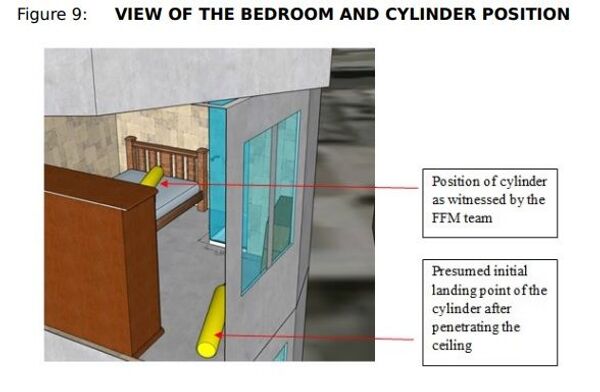
OPCW Report Changes: From 'Inconsistency' of Evidence to 'Likely' Chlorine
Addressing numerous reports of people suffering from chemical attack symptoms and the abundance of footage showing the aftermath of the alleged assault in Douma, the interim report directly calls out the "inconsistency" of this second-hand evidence. Furthermore, the first draft of the paper points out numerous inconsistencies between the symptoms reported by witnesses and those that would have actually been caused by a chlorine attack with the use of the cylinders that were found.
"The rapid onset of heavy salivation and frothing from the mouth would be more consistent with exposure to a highly toxic nerve agent than a chocking agent such as chlorine or phosgene. However, analytical results shown no indication of organophosphorus nerve agents or their degradation products present", the interim report said.

Most of the local doctors questioned by the FFM came to similar conclusions, although the report highlights their lack of knowledge on the subject. In addition, the OPCW team reported in the first draft of the document that it was unable to analyse the bodies of those who died on the day of the alleged attack, as they had already been buried by the notorious White Helmets group at an unknown location.
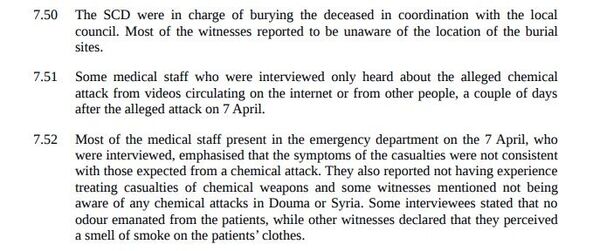
Based on these findings, the interim report concluded that "the fatalities [on that day] resulted from a non-chemical-related incident"; however, none of these findings, witness testimonies, or conclusions made it into the final report. Instead, the document states that "sufficient evidence" had been found to "determine that chlorine, or another reactive chlorine-containing chemical, was likely released from cylinders" and added that the OPCW was continuing to look further into the incident.
How Could Such Drastic Changes Be Made?
Some of the documents released by WikiLeaks shed light on how the initial report transformed into what was officially published. According to a memo written by one of the fact-finding mission members to the OPCW's director-general, an absolute majority of the FFM team that actually visited Douma did not participate in writing the final report, with the exception of one paramedic.
Instead, it was written by a newly assembled "FFM core team", which consisted of FFM members who travelled to "Country X". While it's unclear which country the author of the memo refers to, WikiLeaks suggested that they might be talking about those from the FFM team who visited Turkey in order to question some of the witnesses. The memo's author concludes that since almost none of the Douma FFM team members participated in drawing up the final report, it would not represent the team's evaluation of the incident.
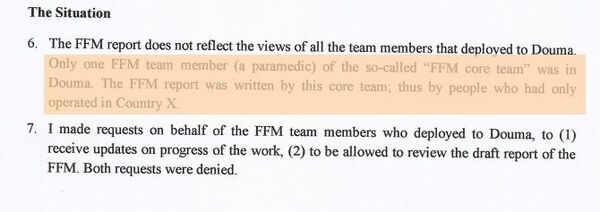
The author of the memo added that the fact that the "FFM core team" didn't take any external comments or reviews into consideration when writing the final report only contributes to the feeling that it misrepresented the Douma FFM team's findings at the sites in Syria. The author said that they were excluded from the work on the report at one point without any reason being given, but decided to make their own review of the situation in Syria and submit it for the "core team's" consideration. The team, however, ignored it completely.
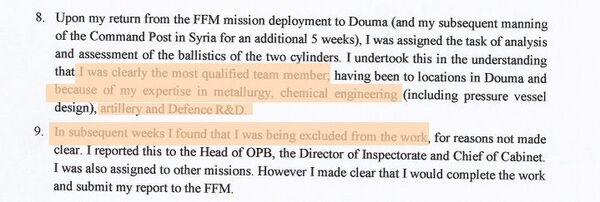
The memo stated that after all of the Douma FFM team members were excluded from working on the report, the document’s conclusions "turned completely in the opposite direction" from what the team originally intended to say. According to the author, the FFM team on the ground had found "indications of serious inconsistencies in findings", namely in regards to damage done to the cylinders, while the final report makes no mention of this.
Douma “Chemical Attack” and Previous Leaks on OPCW Report
This is not the first time that leaks suggest the OPCW report's contents were redacted by superiors in the international organisation. In November 2019, WikiLeaks published an internal OPCW email that showed a member of a fact-finding mission in Douma expressing concern that the organisation's report on the alleged incident had "morphed into something quite different to what was originally drafted" by the FFM team, arguing that some crucial details had been omitted and the facts twisted.
The OPCW report was supposed to determine whether or not an actual attack with the use of prohibited chemical weapons took place in Douma, Syria in 2018. The allegations were triggered by a video created by the White Helmets that showed the group's members treating alleged attack victims at a local hospital.
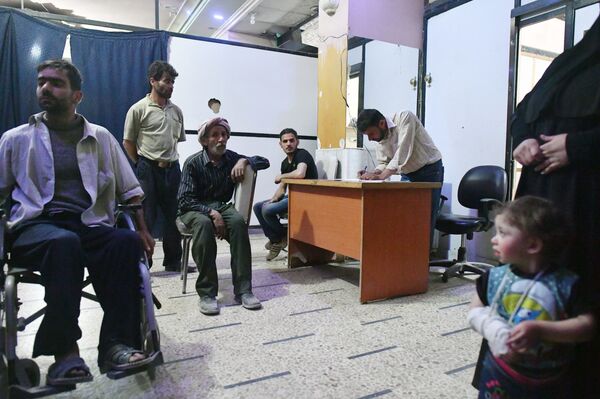
Damascus and Moscow called the video "staged" and accused the White Helmets of staging a false-flag attack in order to condemn the Syrian government and justify foreign intervention in the country. Damascus has repeatedly denied claims of carrying out such strikes, noting that its entire chemical weapons arsenal had been destroyed under the supervision of the OPCW back in 2013.
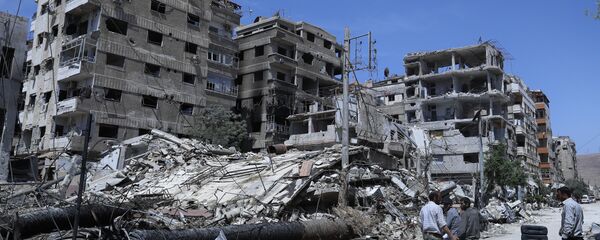
But despite Syria's statements and the fact that the OPCW had not yet verified the White Helmets' claims, the US, UK, and France made a decision to launch a massive one-time missile strike against the Syrian government that claimed the lives of six soldiers and three civilians. The three countries claimed to have targeted objects related to chemical weapons production. Moscow and Damascus harshly condemned the strike.

